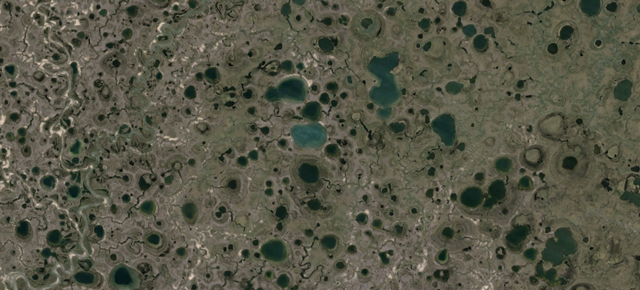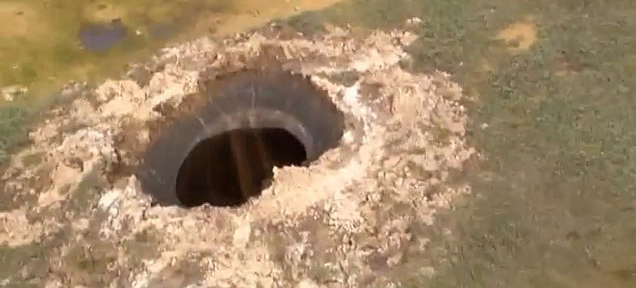By now, you’ve likely seen the mysterious, yawning hole that appeared in Russia’s remote Yamal peninsula, a place whose name literally means “the end of the world”. How perfectly spooky! But now that scientists made it out to investigate the hole, let’s sort out the facts, conjectures, and conspiracy theories about how it came to be in the first place.
In case you haven’t been following the whole — hole? — saga, Yamal first came across our internet conscious when some incredible helicopter flyover video was posted online last week. The grainy footage showed a hole swallowed in black, with rocks and dirt strewn all around. It’s estimated to be 80m in diameter and 60m deep. It is, in short, one hell of a hole.
What It’s Not
Since that first discovery, a little more information has trickled out about the crevasse — enough, at least to cross a few theories off the list.
Meteorite: “We can definitely say that it is not a meteorite,” a spokesman for the Russian Emergencies Ministry’s regional branch told the Siberian Times. Don’t want to just take their word for it? Take a look at craters actually created by meteors, and you’ll see wide, sloping craters rather than a deep hole like this. It’s also fairly unlikely that a meteorite of this size crashing into earth would have gone unnoticed by seismic equipment.
Sinkhole: Naturally occurring sinkholes actually all result from a specific phenomenon: flowing water eating away soft, soluble rock underground. This is quite common in places like Florida — of course, Florida — not so much in frozen Siberia. Also, earth appears to have been pushed up around the hole, which you wouldn’t see in a natural sinkhole.
Aliens: C’mon.
What It Might Be
Perhaps the most compelling visual evidence that the hole is the result of natural geological phenomenon characteristic to Yamal is this photo. Fire up satellite view in Google Maps, and you’ll find Yamal’s landscape pockmarked with holes, big and small.

Home to one of the world’s biggest reserves of natural gas, the Yamal peninsula is a geologically interesting place. As global warming accelerates the melting of what has historically been permafrost, the ground is a-changing. The best explanation for this hole, then, is some combination of ice, gas, and global warming, with a little weird geology thrown in. Two somewhat related theories both address this.
Gas Escape: As ice melts, pockets of gas escape violently, not unlike “the popping a champagne bottle cork.” Anna Kurchatova from the Sub-Arctic Scientific Research Center explained how this works to the Siberian Times. According to a reader translation of this Russia video, scientists couldn’t find any evidence of thermal damage to suggest gas had ignited. The simple pressure of the gas escaping was enough to cause the damage.
Pingo Failure: The region is home to geological formations called pingos, which are a basically ice covered by earth. As ice melts, the pingo collapses on itself to leave a crater. “This is obviously a very extreme version of that,” Chris Fogwill of the University of New South Wales told the Sydney Morning Herald. Fogwill also says it’s possible that gas may have been involved in the formation of the hole.
In any case, Russian scientists are hot on the scene of the hole right now. We’ve contacted the team and will update with any additional information. Especially if it turns out to be aliens after all.
